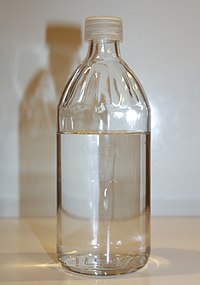
Photo from wikipedia
The photochemical removal of acetaldehyde was studied in N2 or air (O2 1–20%) at atmospheric pressure using side-on and head-on types of 172 nm Xe2 excimer lamps. When CH3CHO was decomposed… Click to show full abstract
The photochemical removal of acetaldehyde was studied in N2 or air (O2 1–20%) at atmospheric pressure using side-on and head-on types of 172 nm Xe2 excimer lamps. When CH3CHO was decomposed in N2 using the head-on lamp (HL), CH4, CO, and CO2 were observed as products in FTIR spectra. The initial removal rate of CH3CHO in N2 was ascertained as 0.37 min−1. In air (1–20% O2), HCHO, HCOOH, CO, and CO2 were observed as products in FTIR spectra. The removal rate of CH3CHO in air using the side-on lamp (SL) increased from 3.2 to 18.6 min−1 with decreasing O2 concentration from 20 to 1%. It also increased from 2.5 to 3.7 min−1 with increasing CH3CHO concentration from 150 to 1000 ppm at 20% O2. The best energy efficiency of the CH3CHO removal using the SL in a flow system was 2.8 g/kWh at 1% O2. Results show that the contribution of O(1D) and O3 is insignificant in the initial decomposition of CH3CHO. It was inferred that CH3CHO is initially decomposed by the O(3P) + CH3CHO reaction at 5–20% O2, whereas the contribution of direct vacuum ultraviolet (VUV) photolysis increases concomitantly with decreasing O2 pressure at < 5% O2. After initial decomposition of CH3CHO, it was oxidized further by reactions of O(3P), OH, and O3 with various intermediates such as HCHO, HCOOH, and CO, leading to CO2 as a final product.
Journal Title: Environmental Science and Pollution Research
Year Published: 2019
Link to full text (if available)
Share on Social Media: Sign Up to like & get
recommendations!